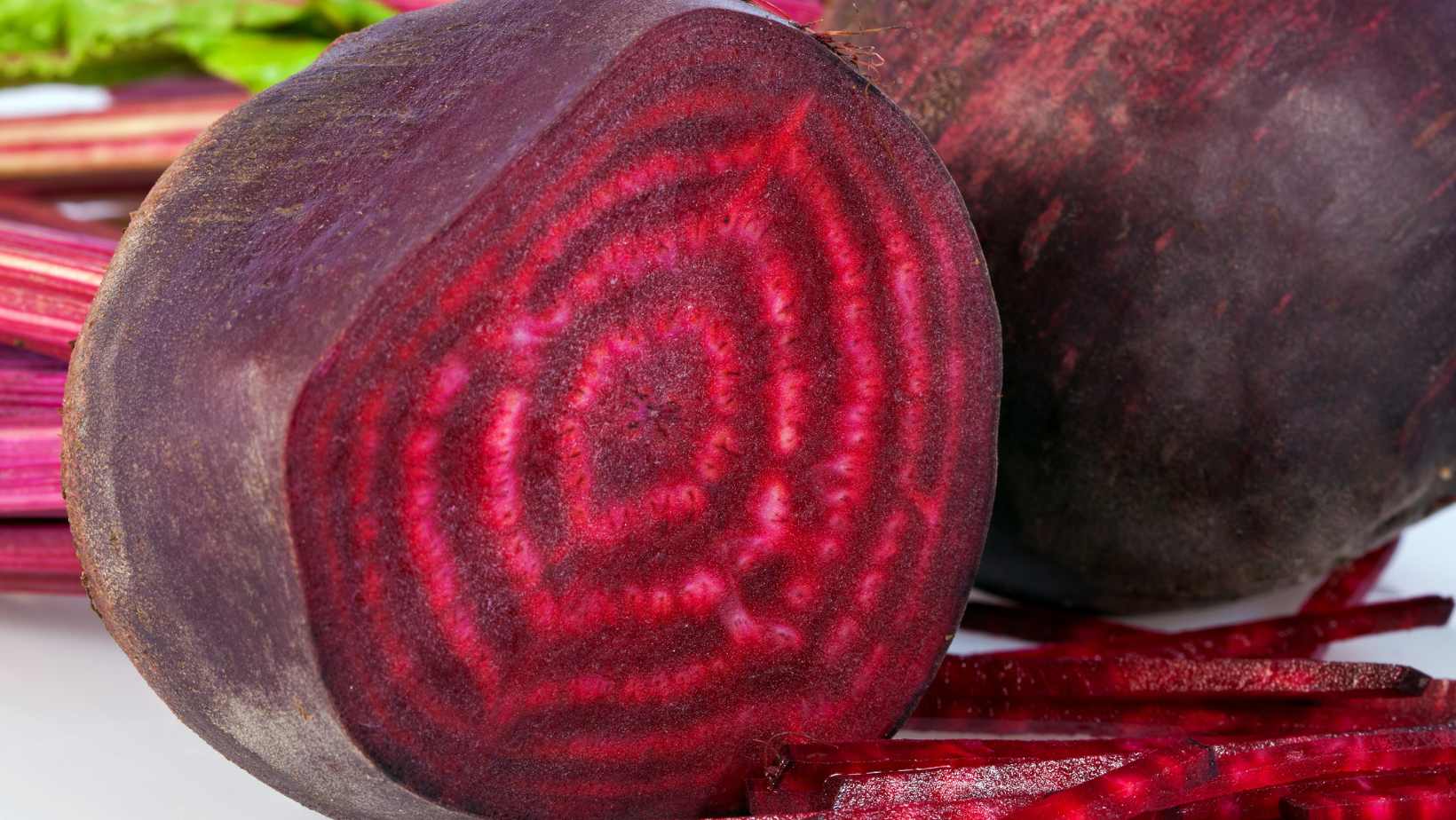For preparing beets, what tools are essential? Here’s four to consider:
- A sharp chef’s knife or a paring knife.
- A cutting board, either plastic or wood.
- Gloves or other hand protection – beets can stain skin and clothing!
- A vegetable peeler (optional, depending on how you want to cook them).
Plus, mandolines can be great for slicing beets thin and evenly. But beware, this tool is sharp, and injuries are possible if it’s not handled correctly.
Vegetable brushes are also handy for cleaning beets and getting dirt off their skin.
But don’t make the mistake of using a dull knife. It’ll result in uneven cuts and some serious frustration. So make sure your knives are sharp before you start!
How to Cut Beets
To prepare beets for cutting, you need to know how to clean them and remove the stems and leaves. These simple steps will ensure that the beets are ready for any dish you have in mind. Clean beets for a fresh taste and remove the stems and leaves for easy cutting.
Cleaning beets
Before cutting beets, it’s essential to clean them! Here’s a 6-step guide:
- Fill a bowl with cold water. Put the beets in it.
- Use a veggie brush under running water to scrub each one. Get rid of dirt in crevices.
- Trim off both ends with a knife. Don’t remove too much – it could affect taste.
- If your beet has any damage or imperfections, cut them out with the tip of the knife.
- Rinse each beet under running water until no dirt remains.
- Dry the beets with paper towels or air-dry them before cutting.
If unsure if a beet is clean enough, repeat steps 2 and 3. Failures here have big risks – bad hygiene in the kitchen! To avoid trouble, follow these steps. Don’t be a sap – get rid of those greens. Beet prep leaves them behind!
Removing Stems and Leaves
Once you’ve got your beets, it’s important to get them ready for cutting.
- Step 1: Grab the beet by its root.
- Step 2: Cut all but one inch of the stem off the top, using a sharp knife.
- Step 3: Cut off all the leaves, leaving only the “vein” on the back of the leaf attached.
- Step 4: Discard or compost the trimmed beet greens.
Note that trimming the beet greens beneath an inch will help retain moisture and give them a longer shelf life.
Now that you’ve removed the greens and trimmed them, you can move on to the next step in preparation. When peeling raw beets, put on gloves or rub some lime juice on your hands. This will prevent discoloration from the beet juice and make working with them easier and less messy.
Follow these steps and you’ll soon be making delicious homemade meals with fresh-cut beets. Get ready to show off your inner samurai with the various cutting techniques for beets!
Techniques For Cutting Beets
To master the art of cutting beets, you need to know the right techniques. This section on “Techniques for cutting beets” with sub-sections on “How to cut beets into rounds, How to cut beets into cubes, How to julienne beets” offers you solutions. Read on to get the hang of each method and cut your beets with ease.
How to cut beets into rounds
Cutting beets into circular pieces requires a specific technique. First, ensure the beet is washed and peeled. Then:
- Slice the top off with a sharp knife.
- Cut the beet in half.
- Place a half cut side down on a cutting board.
- Cut to the desired thickness – ¼ to ½ inch – using a sharp knife.
- Repeat with the other half.
Voila! Evenly cut circular pieces of beets. Be aware that beets tend to stain hands and surfaces, so wear gloves and wash utensils soon after.
Pro Tip: Use a mandoline slicer for even slices, thin enough for salads or pickled beets. Make sure your knife skills are top-notch – otherwise, you might end up with beet soup instead of cubes!
How to cut Beets Into Cubes
Do you want to cut beetroots into dice? Here’s how!
- Wash the beetroots first.
- Cut off both ends and remove the rough skin.
- Slice the beet in half using a big knife and a chopping board.
- Then, cut each half into thin slices and dice them.
- To get even cubes, use a vegetable chopper.
My sister used to struggle with this, but after following the steps, she can cut neatly. Julienning beets is a great way to exercise your knife skills and patience, since they’ll dye everything!
How to Julienne Beets
Julienning beets is a technique to cut them into thin strips. To do this:
- Wash & peel the beetroot.
- Cut it into 1/8-inch slices.
- Stack the slices & slice lengthwise into thin sticks.
- Aim for strips that are 1/8-inch wide and 2-3 inches long.
- Lay the strips flat & tidy up any uneven edges.
- Put the julienne cut beets in cold water until you use them.
Experiment with different cuts, like batons, cubes or wedges to spice up your dish. Wear gloves while handling beetroots – they stain skin & clothing. And be careful when using sharp knives – always work at your own pace to avoid injuries!
Tips For Easier Beet Cutting
To make your beet cutting easier, follow these tips for using a sharp knife, mandoline, slowing down and being careful. A sharp knife can make clean cuts and prevent slips. Using a mandoline can speed up the process but requires careful attention. Slowing down and being careful can prevent injuries and help you enjoy the process.
Using a Sharp Knife
Sharp blades are a must for effective beet cutting. A dull knife can be a challenge and even cause injury. Here’s how to make the most of a sharp blade:
- Get a quality knife for slicing and dicing veg.
- Stay sharp by frequently honing or sharpening the blade.
- Always clean with soap and water before use, then dry.
- Grasp the grip and hold the beet steady with the other hand. Slice from top to bottom using short, swift motions.
- Press evenly, not too hard in one spot, or the cuts could be uneven.
Sharp knives make beet cutting easier and safer. Handle carefully to prevent accidents. Invest in a quality knife for effortless slicing and long-term performance. Get one today! And if you’re feeling brave, try a mandoline – it’s a risky venture but so worth it!
Using a Mandoline
A mandoline slicer is a great tool for effortless slicing of beets! Follow these 6 steps for a uniform cut:
- Set up the mandoline on a flat surface.
- Choose a blade for your desired slice thickness.
- Hold the beet steady with one hand and slide it against the blade with the other.
- Repeat until all beets are sliced.
- Carefully remove leftover pieces or scraps from the blades.
- Clean the mandolin immediately.
Adjust the blade type for best results. Don’t apply too much force, as it can damage both blades and beet. Wear gloves to avoid staining your hands. Cutting beets is tricky, so be careful to avoid the wrong slice!
Slowing Down and Being Careful
To make beet cutting easier, take a mindful approach and be aware. Slow down and focus to reduce the risk of injury. Be more careful for better precision. Use a sharp knife, grip the beet firmly, and slice with intention. Place a non-slip cutting board to prevent slips and accidents. Pay attention to hand placement and posture.
Divide large beets into smaller sections before slicing. This makes them easier to cut. Wear gloves to protect hands from staining and for added safety. Pro tip: Beets make perfect additions to salads, soups, or vampire repelling stews!
Recipes Using Cut Beets
To make the most out of cut beets that you have prepared, you can use them in a variety of recipes. In order to elevate your beet game, this section will explore some of the exciting recipes using cut beets, such as roasted beet salad, beet chips, and beet juice. These subsections offer a range of flavours and preparation methods to help you experiment with different ways to incorporate cut beets into your meals.
Roasted Beet Salad
Tantalise your taste buds with Roasted Beet Delight! Crispy beets sliced and roasted with olive oil to perfection, arugula for a crunchy twist, tangy goat cheese, balsamic vinaigrette dressing, sweet red onions, and walnuts for an earthy flavour.
Not only delicious, but nutritious too! Fibre, proteins, vitamins, and minerals all packed in one dish. Don’t miss out on this culinary adventure – try it today! Who needs potato chips when you can have these crimson crispy delights? Don’t beat around the bush, give them a try!
Beet Chips
For a unique twist on potato chips, try making savoury and crispy beet chips. Here’s how:
- Choose medium-sized beets with firm flesh and smooth skin.
- Slice the beets as thinly as possible with a mandoline or sharp knife.
- Use paper towels to dab away excess moisture.
- Toss the slices in a mix of olive oil, salt, and seasonings.
- Bake at 375°F for 10-15 mins or deep-fry for 2-3 mins until golden and crispy.
Mix it up with different spices and dips like tzatziki, hummus, or ranch. These chips make a great healthy snack or salad topping. Or, if you’re short on time, why not drink your veggies instead? Beet juice is an easy option!
Beet Juice
Beet juice – a popular drink known for its bright, vibrant colour – is made from extracted beets. It’s packed with nutrients like vitamin C, folate, and potassium.
Some suggest it may reduce inflammation and support blood flow, and even help with exercise endurance and blood pressure regulation. It has a tangy taste that can be balanced with sweet fruits or honey when making smoothies. For an extra refreshing experience, serve it chilled.
If you’re storing cut beets, remember: out of sight, out of mind! Or else they’ll transform into a science experiment in your fridge!
Storing Cut Beets
To store cut beets properly with tips for cutting beets, you need to know the best storage methods for short-term and long-term storage. Short-term storage involves keeping the beets in the refrigerator for a few days, while long-term storage requires freezing them. Let’s walk through the benefits of each sub-section, so you can choose the best option for your needs.
Short-Term Storage
Short-Term Storage:
Retain the freshness and nutrition of cut beets for a while? Here are tips:
- Keep them in an airtight container with the lid shut tight.
- Sprinkle water every few days to maintain moisture.
- Refrigerate at 32- 40°F.
- Away from sunlight and ethylene-producing fruits.
- The cut beets can stay fresh for up to seven days.
- Pre-cut or peeled baby beetroots can last four weeks if unopened.
Cooked beetroot is not recommended to store. Consume within two hours after cooking. Depends on how prepared & exposed before refrigerating.

History:
Beetroot has been eaten for centuries. Rich in vitamins, antioxidants, fibre & minerals. Ancient cultures – Babylonia, Greece & Rome – used it for health benefits. Colchester, Britain, farmers began cultivating in the early sixteenth century. Beetroot became popular in Eastern Europe. Recipes like borscht – a hearty soup made of red beets – spread globally. Store your beets long-term for ruby red salads in an apocalypse!
Long-term Storage
Storing Cut Beets – Professional Long-term Preservation.
Tips for successful storage:
- Clean and dry cut beets.
- No freezing.
- Store in an airtight container – glass or plastic.
- Refrigerate at 32-40°F (0-4°C).
- Add lemon juice for increased shelf life.
These guidelines ensure freshness for about a week.
Maximise preservation and reduce waste – store only what you plan to consume. Monitor storage conditions regularly to avoid spoilage.
Safety first! Wear gloves when cutting beets – no one wants a side of blood.
Safety Precautions When Cutting Beets
To ensure safe and effective beet cutting with less mess and injury, follow some basic safety precautions. When cutting beets, different stains can make a mess, so it is important to follow staining and cleaning precautions. Knife safety is an important part of beet cutting as it can cause serious injury if not handled properly. In order to prevent accidents and maximise the effectiveness of beet cutting, take appropriate safety measures for both staining and knife safety.
Staining and Cleaning Precautions
When handling beets, precautions are key. Here’s what to do:
- Wear gloves to prevent staining skin.
- Use a cutting board that can be easily cleaned to avoid countertop or table stains.
- Rinse any beet juice spills or drips with cold water to avoid fabric staining.
- After cutting beets, wash any utensils, knives, and cutting boards in cold water and mild dish soap.
Beet stains can be tough to remove from clothes. To prevent damage, pre-treat the stain by soaking the garment in cold water before washing.
These simple tips can save you time and frustration. Taking care when dealing with beets will reduce the risk of stains and make cleanup easier.
Interestingly, ancient Greeks believed beets could increase libido and were an aphrodisiac. Although there’s no scientific proof, it’s clear that beets have been valued for thousands of years for their flavour and health benefits. Cutting beets correctly is a root to success – just don’t lose a finger!
Knife Safety During Beet Cutting.
When slicing beets, safety is key. Here’s how:
- Sharpen the knife for easy slicing.
- Keep hands away from the blade – use a claw grip or a cutting board.
- Use a stable, secure cutting surface.
- Cut slowly and carefully – let the blade do its job.
- Don’t use excess force.
- Store knives far away from kids or animals.
Plus, wear cut-resistant gloves or get special beet-cutting tools.
Remember, knife safety is important. Taking precautions helps avoid injury in the kitchen.
















































